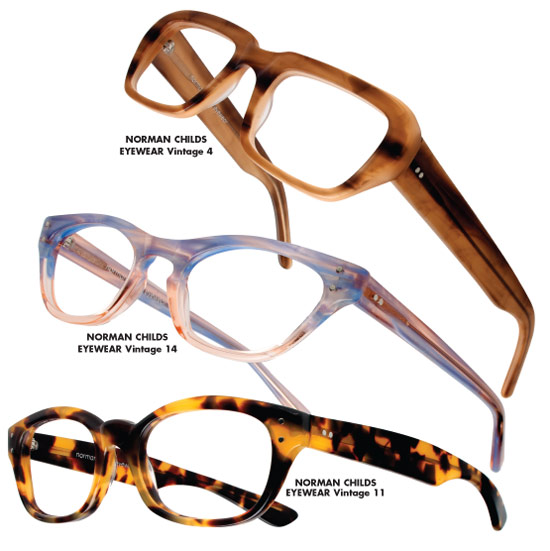Glasses aren't just for seeing anymore.
Thanks to a spectrum of shapes and shades, spectacles have become a fashion accessory for the nearsighted, farsighted and even clear sighted.
"
![Oliver Peoples]()
Consumers have been, and continue to be, more interested in buying eyewear as an accessory instead of solely out of necessity," says Jenna LaRoche, a spokeswoman for the Vision Council, which tracks trends and data related to eyewear. "Influence from celebrities and runway fashions have certainly played a role in this."
Recently, many designers have been dabbling in eyewear. Victoria Beckham partnered with London-based Cutler & Gross for a line of stylish frames. For the past couple of years, the Council of Fashion Designers of America and Luxottica have tapped designers such as Rebecca Minkoff, Kara Ross, Nanette Lepore and Yeohlee to create limited-edition collections for Vogue Eyewear.
Some seek glasses to add a pop of color to an outfit. Others want them for a maturity boost when interviewing for a job, despite having perfect vision, says Norman Childs, whose Eyetique has locations across the city, including South Hills Village, Pine and Shadyside.
In Pittsburgh, there are several boutiques that specialize in luxury glasses and the personal attention necessary to navigate this sea of specs.
"We really want the right product [for people] because every client that we have represents us, and there's nothing worse than somebody having a pair of glasses they don't like," Mr. Childs says.
His eyewear boutiques and examination centers were among the first of their kind in Pittsburgh ![Norman Childs Eyewear Vintage 13]() when he opened in Squirrel Hill in 1979, he noted. What put him on the map in the 1980s was carrying frames by Oliver Peoples, back then just a single store on Sunset Boulevard in California. It took some convincing to nudge the budding designer eyewear business to provide him with frames to sell, but the outcome was overwhelming.
when he opened in Squirrel Hill in 1979, he noted. What put him on the map in the 1980s was carrying frames by Oliver Peoples, back then just a single store on Sunset Boulevard in California. It took some convincing to nudge the budding designer eyewear business to provide him with frames to sell, but the outcome was overwhelming.
"I sliced the box open and literally people were buying them out of the box from me," he says. "That started us off in this luxury market of optical."
Today, Mr. Childs also stocks his own line of glasses, most of which are handmade in a small factory in California. Other collections available at Eyetique include Robert Marc, Bevel, Face a Face and Theo.
"Our business is growing, so that's telling me that people appreciate beautiful product, handmade product, things you just can't buy anywhere," he says.
Other high-end eyewear boutiques have popped up over the years across Pittsburgh, such as Heidioptics, Downtown, and ILORI at Ross Park Mall. Some of them have sensed similar demands for fashionable, well-crafted glasses.
"I think people want quality," says Katie Rau, an optician at Eyepolis at the Waterfront, home to an ophthalmologist and eyeglass styles by designers from across the globe, including Mykita (Berlin), Kilsgaard (Denmark) and Koali (France). It also sells better-known brands, such as Oakley and Ray-Ban.
She keeps up on latest trends and new designers by attending eyeglass shows, such as the International Vision Expo this month at the Javits Center in New York City.
There are many looks -- at price points that range from a couple hundred into the thousands -- attracting attention for spring. Color is one of the biggest trends for women, from pastels to neons, according to the Vision Council. Matte orange and green are other hues growing in popularity. Some eyewear is showing signs of 1980s influences as frames become larger and rounder, a switch from the recent surge of chunky rectangular frames. For a retro vibe, there are plastic pairs and ones with cat eyes. Even people with smaller faces can try some of these oversized shapes, as there are now designers who make them on a petite scale, Ms. Rau says.
Color also is key for men, particularly rich reds and bold blues. The Vision Council is calling for "an old-school revival," thanks to a resurgence in round frames, brow bars and modernized aviators. For the classic guy, there are clean, sleek frames in cool colors, such as gray, black and metal. And don't forget about clip-on lenses -- they are another option.
Sticking to something traditional? Want to take a risk with your readers? Specialty boutiques help shoppers find the pair that works best with their life and personal style. For those enticed by eyewear for style purposes, plano lenses without prescriptions are available.
"I want to make sure our clients and customers come in feeling great and leave feeling great," Mr. Childs says. "We put that at a very high level. That's what's built our business."


































